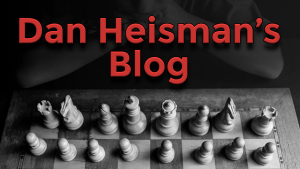Good Traps and Bad Traps: The Maung Story
Let's attempt to define a good trap:
"Setting up an attractive, but faulty, sequence for the opponent that, if followed, would allow a tactic or, at least, a forcing sequence unfavorable for that opponent. However, if the opponent avoids that move/sequence no real harm is done to your position."
In other words, with a good trap you get something for nothing: if the opponent falls for the trap, you might win, but if he doesn't, no harm is done.
This is the opposite of a bad trap, which also offers a seemingly reasonable sequence that, if fallen into by the opponent, would allow you to do something harmful to him. But that's where the similarity ends: in a bad trap if your opponent manages to see it and avoid it then, in doing so, you have allowed yourself to harm your position.
Setting bad traps is a risk that weak players, intentionally or not, often take, because their similarly weak opponents often fall for the trap and justify such risky play. It's very similar to the observation that weak players make "bad threats" in the hope the opponent overlooks the threats and allow an easy win. Since the opponents often do overlook these threats, the offering of "bad threats" seems psychologically justified. It's a temptation that almost everyone has to overcome in order to become an intermediate player, where the opponents usually spot cheap threats and avoid them.
This brings me to The Maung Story. Maung was a friend of my son Delen; they played together as teenagers. Today Maung is a physician, so its been a while!
Maung was playing at a local tournament, had the White pieces, and his game began 1.e4 e5 2.Nf3 Nf6 3.Nc3 Nc6 4.Be2?! d5 5.exd5 Nxd5 6.Nxd5(?) Qxd5 7.O-O(?):
Here Maung's opponent played 7...e4 and, although it was a G/30 event (if I remember correctly), Maung thought a few minutes about his reply. What would you play?
Maung decide to play 8.Re1. What would you do for Black?
Black quickly shrugged his shoulders and slid 8...Be7
By playing 8.Re1? and setting the trap 8...exf3? 9.Bxf3+ winning the queen and pawn for a rook and knight, White also removed his knight's only escape square. White's knight is now trapped. After 8...Be7 Maung unhappily sank back in thought, but to no avail. The knight and the game were lost.
Maung's 8.Re1? is an excellent example of a Bad Trap.
Instead White should have just played the safe "retreat" 8.Ne1 followed by d3 with a decent game. The computer suggests White could throw in 8.c4 before 9.Ne1 but that doesn't make much difference.
I am sure you can find many "good traps" just by playing through any set of annotated master games, looking for spots where the author writes "Of course not move X, because then reply A wins, e.g. with sequence ABC". How do I know this is likely a good trap? Because, unless they are desperate, masters don't set bad traps and then hope the opponent falls into it (and no, this is not my definition of Hope Chess  ). Instead they play strong moves that might, on occasion, also contain good traps.
). Instead they play strong moves that might, on occasion, also contain good traps.
What would you have done if you were Black and Maung had played 7.Nh4 instead of 7.Re1?
Black should play 7...g5! trapping the knight. This is a great example of Attacking with something Worth Less (AWL), far more effective than the feeble 7...Be7, allowing 8.g3. Sure, in that line after 8...Bxh4 9.gxh4 White's game is a mess, but it's not as bad as being down a piece! If you are afraid to play moves like 7...g5, think of a money analogy: weakening your kingside position is like costing you a quarter but winning the knight is like getting a few dollars. Not all Bads are Equal.






